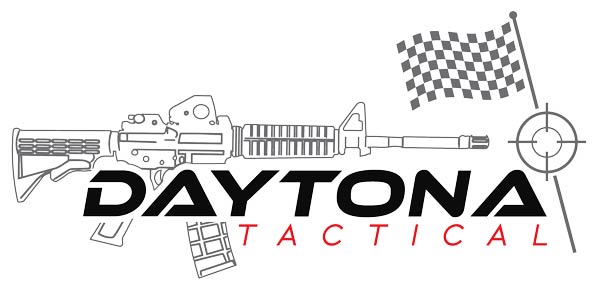Frequently Asked Questions
Daytona Tactical Frequently Asked Questions about the AR-15 Rifle and Its Components
1. What are the main parts of an AR-15?
The AR-15 can be broken down into the upper and lower receivers. The upper receiver includes parts like the bolt carrier group, barrel, hand guard, and more. The lower receiver comprises the stock, buffer tube, trigger, safety, and other small parts.
2. What’s needed to build an AR-15?
While some basic tools can suffice, special tools are optional for assembly. Tools like a bench vise, torque wrench, gunsmith’s wrench, and more are crucial for a successful build. A variety of punches, hammers, and screwdrivers are also helpful.
3. What parts are required to build an AR-15?
To build an AR-15, you need components like upper and lower receivers, barrel assembly, bolt carrier group, lower parts kit, stock assembly, and various small parts. These components can also be customized based on your preferences.
4. How long does it take to build an AR-15?
The time to build an AR-15 varies depending on your experience and also the complexity of the parts. Assembling a complete receiver takes less time than building from stripped receivers. Additionally, with practice, you can potentially complete an AR-15 build within a couple of hours.
5. Is it cheaper to build or buy an AR-15?
The cost of building versus buying an AR-15 depends on the components you choose. While building allows customization, costs can add up. Carefully consider your needs and budget before deciding whether to build or buy.
6. Is an upgraded trigger worth it for an AR-15?
Upgraded triggers offer advantages like better control over trigger pull weight and a personalized fit. While standard triggers are functional, aftermarket options can enhance accuracy and shooting comfort.
7. Why should I build my own AR-15?
Building an AR-15 is not only enjoyable but also educational. It also provides insights into the firearm’s inner workings and allows you to troubleshoot and repair issues. A deeper understanding of your AR-15 additionally enhances your ability to use it effectively.
8. What’s included in an upper receiver?
An upper receiver’s made up of components like the bolt carrier group, barrel, hand guard, charging handle, forward assist, and ejection port cover. These parts work together to facilitate firing and ejection.
9. What’s included in a lower receiver?
A lower receiver includes parts like the stock, buffer tube, trigger, magazine catch, pistol grip, selector, and takedown pins. These components also contribute to the firearm’s handling and operation.
10. Can I build an AR-15 from the Parts from Daytona Tactical without special tools?
While it’s technically possible, specialized tools ensure precise assembly and reduce the risk of damage. Additionally, using proper tools improves the quality of your build and the performance of your AR-15.
11. Does Daytona Tactical Suggest any optional parts to upgrade my AR-15 Rifle?
Yes, there are various aftermarket components to enhance your AR-15, such as bipods, foregrips, optics, lasers, slings, upgraded triggers, vertical grips, and weapon mounted lights.
12. What’s the role of the bolt carrier group?
The bolt carrier group is a critical component responsible for chambering rounds, firing, extracting spent casings, and ejecting them. It consists of multiple parts working together to facilitate the firing cycle.
13. How can I upgrade the performance of my AR-15?
You can also customize your AR-15’s performance by selecting components like barrel length, hand guard type, muzzle device, trigger, and optics. Each choice can impact accuracy, recoil, and overall shooting experience.
14. Can I build an AR-15 to my specific needs from the parts from Daytona Tactical?
Absolutely. Building your own AR-15 allows you to also tailor it to your exact needs and preferences. You can choose components optimized for your intended use, whether it’s hunting, home defense, or recreational shooting.
15. What’s the advantage of separating the upper and lower receivers for cleaning?
Separating the upper and lower receivers simplifies the cleaning process. Additionally, it allows you to access critical parts, such as the bolt carrier group and buffer assembly, for thorough cleaning and lubrication, ensuring regular performance.
Enjoying this AR-15 content? Also, subscribe to our newsletter to receive more valuable information and tips for firearm lovers!
What is an 80% Lower?
An 80% lower receiver is a piece of material (Aluminum) which has been partially completed to a certain point.
Is an FFL required to build a firearm for personal use?
No. You are building the firearm for yourself for your own personal use which is legal under the Gun Control Act of 1968. This is on the ATF’s website under their FAQ page. You can see it here http://www.atf.gov/firearms/faq/firearms-technology.html
It is not required to be transferred through a Federal Firearms License Dealer with all the federal paperwork like its finished counterpart, the completely finished lower receiver. Additionally, these factors make for easy purchasing for home gunsmiths and hobbyists for personal use.
As long as the following laws are met there are no problems:
- You can legally own the firearm in question in the state in which you live
- You are building the firearm for your personal use and for yourself only.
Also, it is a good idea to mark your firearm somehow so that should it ever be lost or stolen you have a way to identify it and report its loss to your local law enforcement. Please check your local and state laws.
What can the 80% AR-15 Lower Receiver be used for?
It is a great starting point for many firearm calibers including, but are not limited to:
- .223 – 5.56mm
- 6.8 SPC
- 7.62 x 39mm
- 5.45 x 39mm
- 6.5 Grendel
- .50 Beowulf
- 9mm
- .45 ACP
